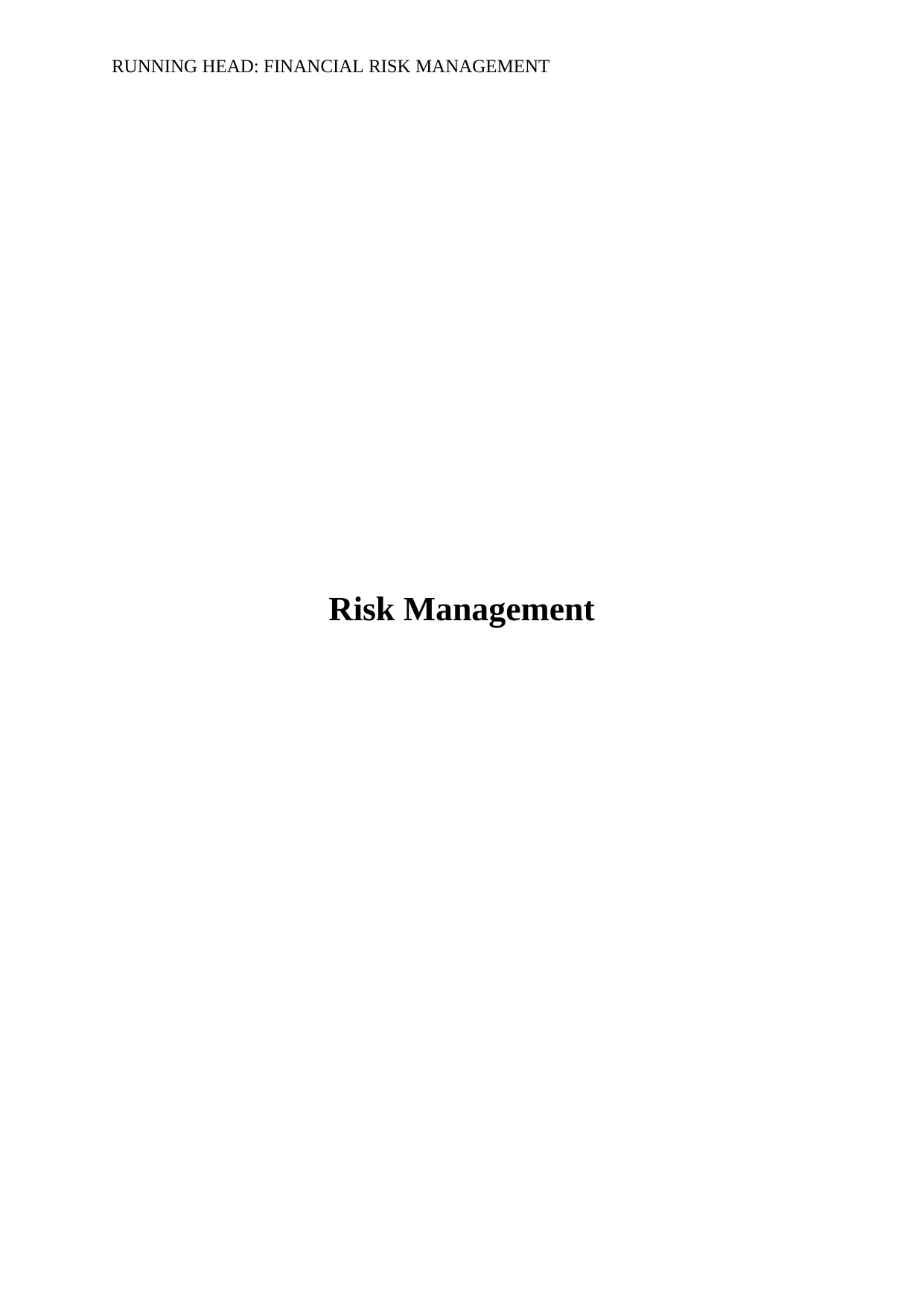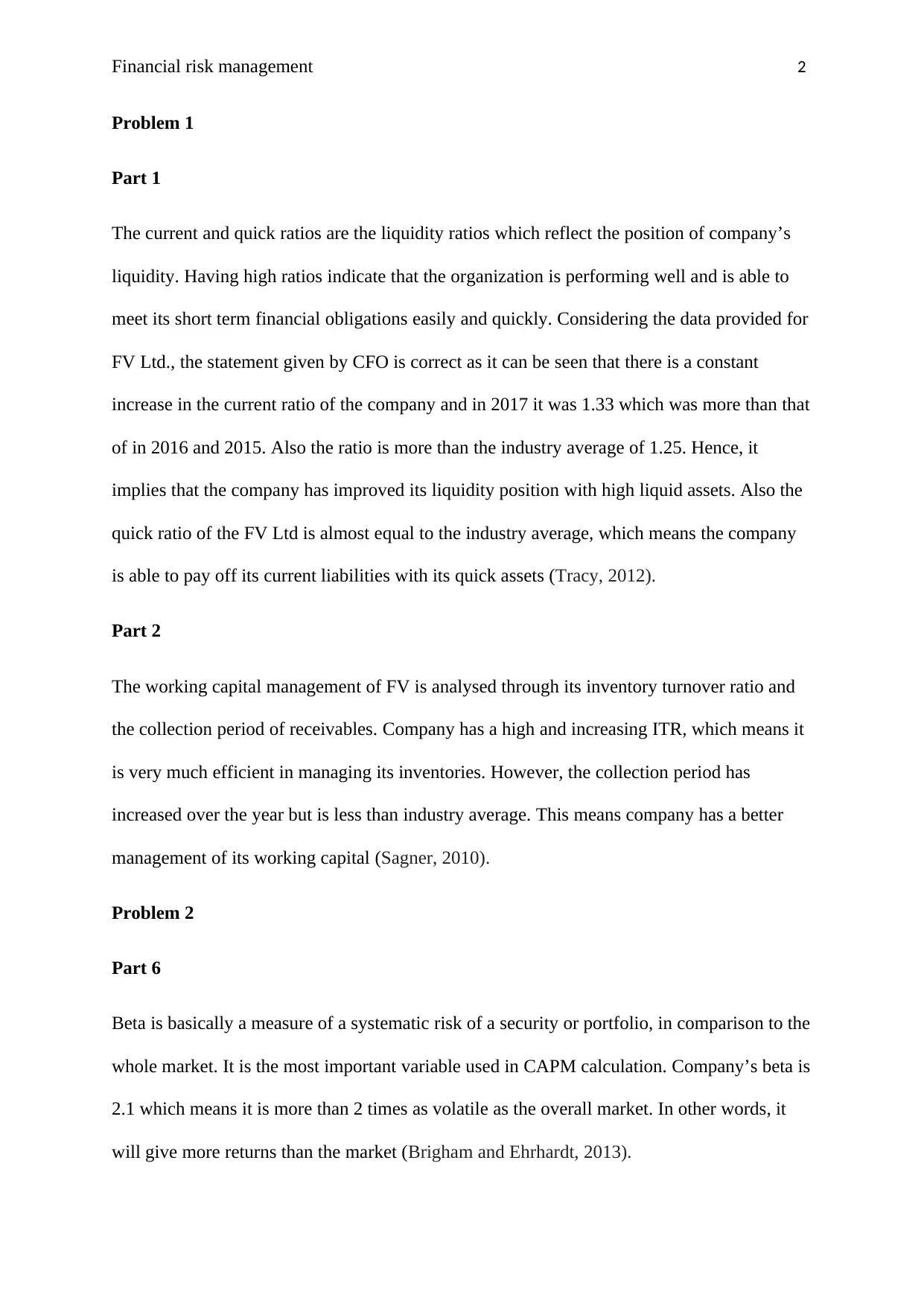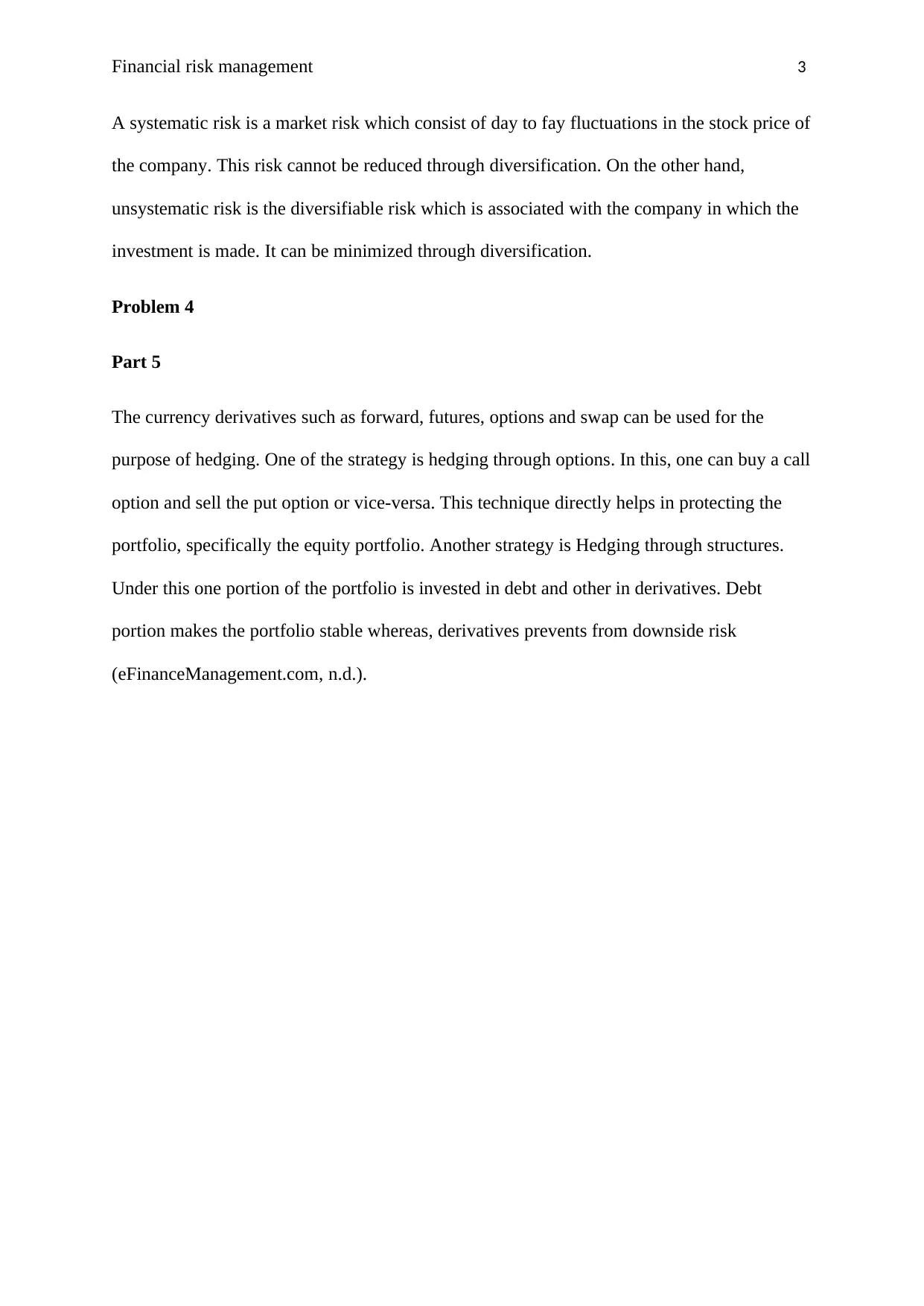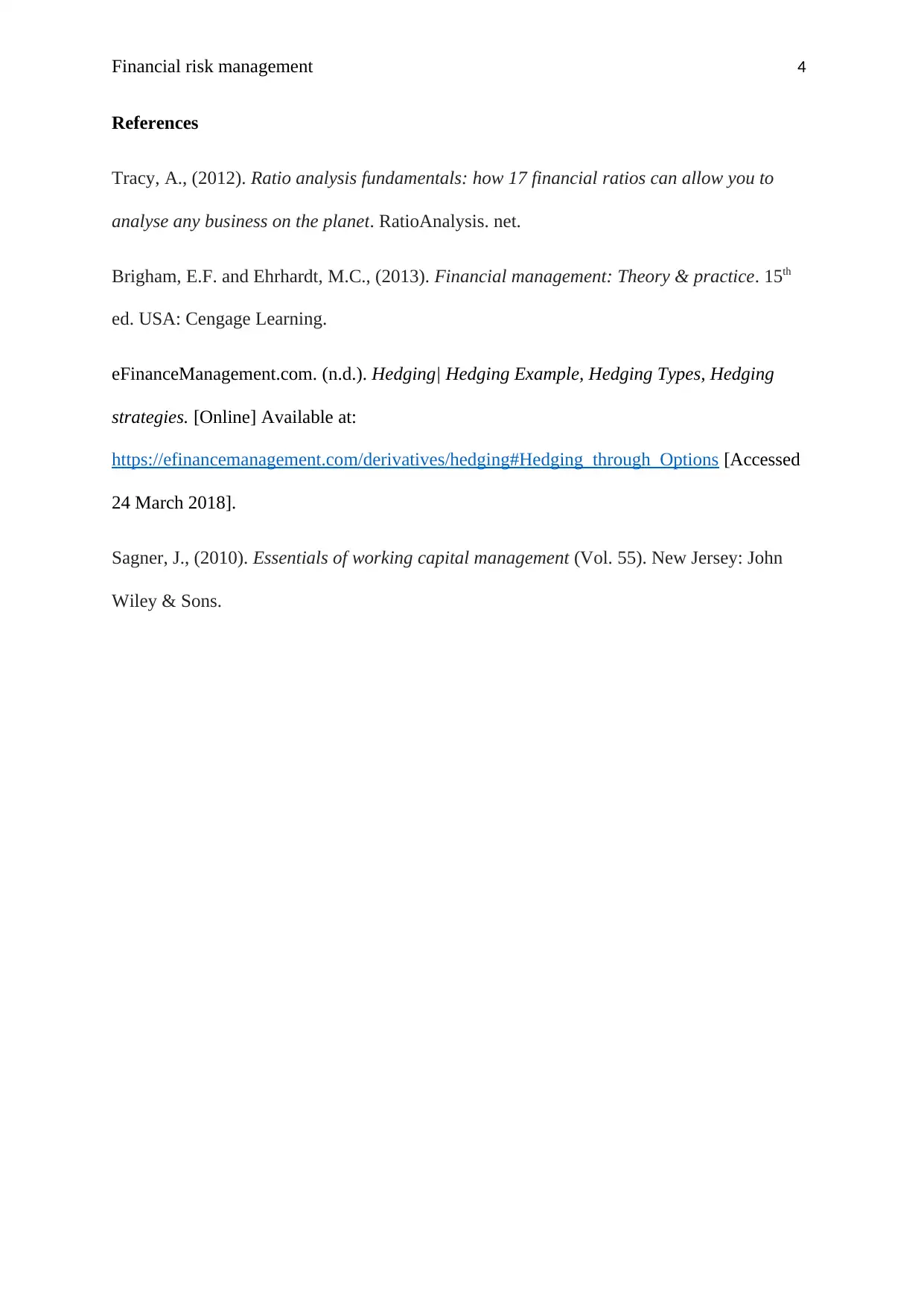Financial Risk Management Report - Analysis, Insights, and Solutions
VerifiedAdded on 2021/04/17
|4
|619
|41
Report
AI Summary
This report provides a comprehensive analysis of financial risk management, focusing on key areas such as liquidity ratios, working capital management, and hedging strategies. The report begins by examining the company's current and quick ratios, comparing them to industry averages to assess ...

RUNNING HEAD: FINANCIAL RISK MANAGEMENT
Risk Management
Risk Management
Paraphrase This Document
Need a fresh take? Get an instant paraphrase of this document with our AI Paraphraser

Financial risk management 2
Problem 1
Part 1
The current and quick ratios are the liquidity ratios which reflect the position of company’s
liquidity. Having high ratios indicate that the organization is performing well and is able to
meet its short term financial obligations easily and quickly. Considering the data provided for
FV Ltd., the statement given by CFO is correct as it can be seen that there is a constant
increase in the current ratio of the company and in 2017 it was 1.33 which was more than that
of in 2016 and 2015. Also the ratio is more than the industry average of 1.25. Hence, it
implies that the company has improved its liquidity position with high liquid assets. Also the
quick ratio of the FV Ltd is almost equal to the industry average, which means the company
is able to pay off its current liabilities with its quick assets (Tracy, 2012).
Part 2
The working capital management of FV is analysed through its inventory turnover ratio and
the collection period of receivables. Company has a high and increasing ITR, which means it
is very much efficient in managing its inventories. However, the collection period has
increased over the year but is less than industry average. This means company has a better
management of its working capital (Sagner, 2010).
Problem 2
Part 6
Beta is basically a measure of a systematic risk of a security or portfolio, in comparison to the
whole market. It is the most important variable used in CAPM calculation. Company’s beta is
2.1 which means it is more than 2 times as volatile as the overall market. In other words, it
will give more returns than the market (Brigham and Ehrhardt, 2013).
Problem 1
Part 1
The current and quick ratios are the liquidity ratios which reflect the position of company’s
liquidity. Having high ratios indicate that the organization is performing well and is able to
meet its short term financial obligations easily and quickly. Considering the data provided for
FV Ltd., the statement given by CFO is correct as it can be seen that there is a constant
increase in the current ratio of the company and in 2017 it was 1.33 which was more than that
of in 2016 and 2015. Also the ratio is more than the industry average of 1.25. Hence, it
implies that the company has improved its liquidity position with high liquid assets. Also the
quick ratio of the FV Ltd is almost equal to the industry average, which means the company
is able to pay off its current liabilities with its quick assets (Tracy, 2012).
Part 2
The working capital management of FV is analysed through its inventory turnover ratio and
the collection period of receivables. Company has a high and increasing ITR, which means it
is very much efficient in managing its inventories. However, the collection period has
increased over the year but is less than industry average. This means company has a better
management of its working capital (Sagner, 2010).
Problem 2
Part 6
Beta is basically a measure of a systematic risk of a security or portfolio, in comparison to the
whole market. It is the most important variable used in CAPM calculation. Company’s beta is
2.1 which means it is more than 2 times as volatile as the overall market. In other words, it
will give more returns than the market (Brigham and Ehrhardt, 2013).

Financial risk management 3
A systematic risk is a market risk which consist of day to fay fluctuations in the stock price of
the company. This risk cannot be reduced through diversification. On the other hand,
unsystematic risk is the diversifiable risk which is associated with the company in which the
investment is made. It can be minimized through diversification.
Problem 4
Part 5
The currency derivatives such as forward, futures, options and swap can be used for the
purpose of hedging. One of the strategy is hedging through options. In this, one can buy a call
option and sell the put option or vice-versa. This technique directly helps in protecting the
portfolio, specifically the equity portfolio. Another strategy is Hedging through structures.
Under this one portion of the portfolio is invested in debt and other in derivatives. Debt
portion makes the portfolio stable whereas, derivatives prevents from downside risk
(eFinanceManagement.com, n.d.).
A systematic risk is a market risk which consist of day to fay fluctuations in the stock price of
the company. This risk cannot be reduced through diversification. On the other hand,
unsystematic risk is the diversifiable risk which is associated with the company in which the
investment is made. It can be minimized through diversification.
Problem 4
Part 5
The currency derivatives such as forward, futures, options and swap can be used for the
purpose of hedging. One of the strategy is hedging through options. In this, one can buy a call
option and sell the put option or vice-versa. This technique directly helps in protecting the
portfolio, specifically the equity portfolio. Another strategy is Hedging through structures.
Under this one portion of the portfolio is invested in debt and other in derivatives. Debt
portion makes the portfolio stable whereas, derivatives prevents from downside risk
(eFinanceManagement.com, n.d.).
You're viewing a preview
Unlock full access by subscribing today!

Financial risk management 4
References
Tracy, A., (2012). Ratio analysis fundamentals: how 17 financial ratios can allow you to
analyse any business on the planet. RatioAnalysis. net.
Brigham, E.F. and Ehrhardt, M.C., (2013). Financial management: Theory & practice. 15th
ed. USA: Cengage Learning.
eFinanceManagement.com. (n.d.). Hedging| Hedging Example, Hedging Types, Hedging
strategies. [Online] Available at:
https://efinancemanagement.com/derivatives/hedging#Hedging_through_Options [Accessed
24 March 2018].
Sagner, J., (2010). Essentials of working capital management (Vol. 55). New Jersey: John
Wiley & Sons.
References
Tracy, A., (2012). Ratio analysis fundamentals: how 17 financial ratios can allow you to
analyse any business on the planet. RatioAnalysis. net.
Brigham, E.F. and Ehrhardt, M.C., (2013). Financial management: Theory & practice. 15th
ed. USA: Cengage Learning.
eFinanceManagement.com. (n.d.). Hedging| Hedging Example, Hedging Types, Hedging
strategies. [Online] Available at:
https://efinancemanagement.com/derivatives/hedging#Hedging_through_Options [Accessed
24 March 2018].
Sagner, J., (2010). Essentials of working capital management (Vol. 55). New Jersey: John
Wiley & Sons.
1 out of 4
Related Documents
Your All-in-One AI-Powered Toolkit for Academic Success.
+13062052269
info@desklib.com
Available 24*7 on WhatsApp / Email
![[object Object]](/_next/static/media/star-bottom.7253800d.svg)
Unlock your academic potential
© 2024 | Zucol Services PVT LTD | All rights reserved.





